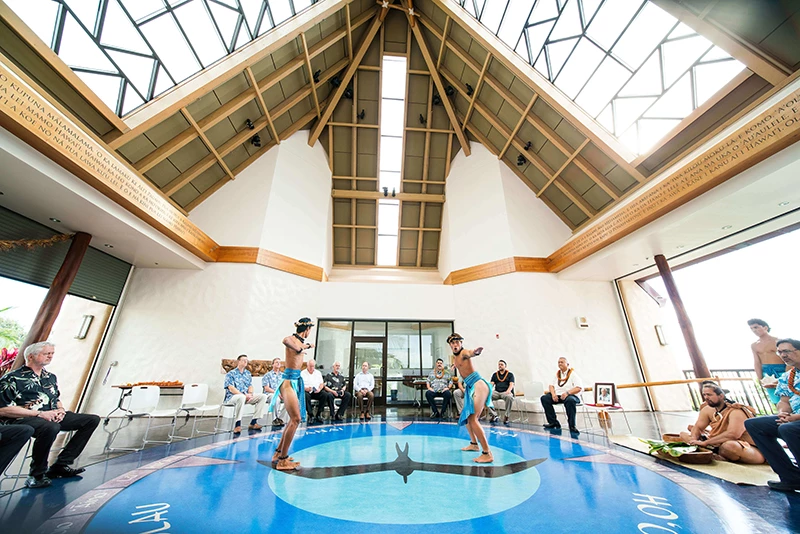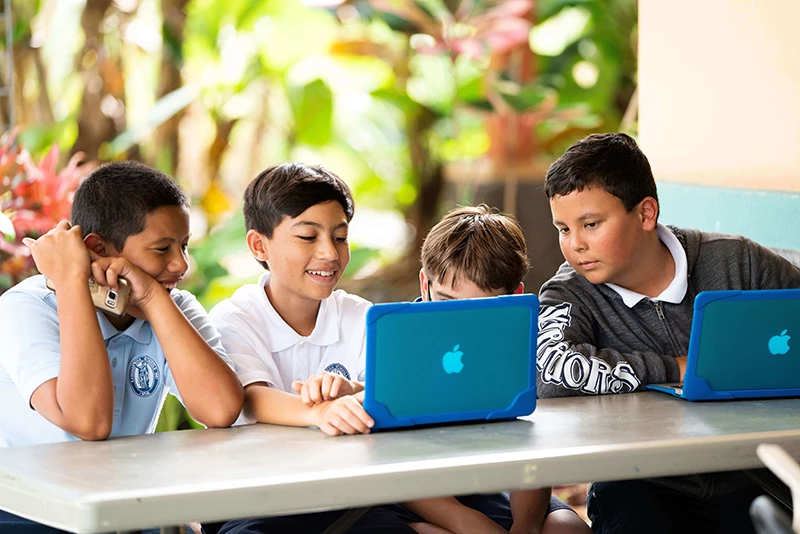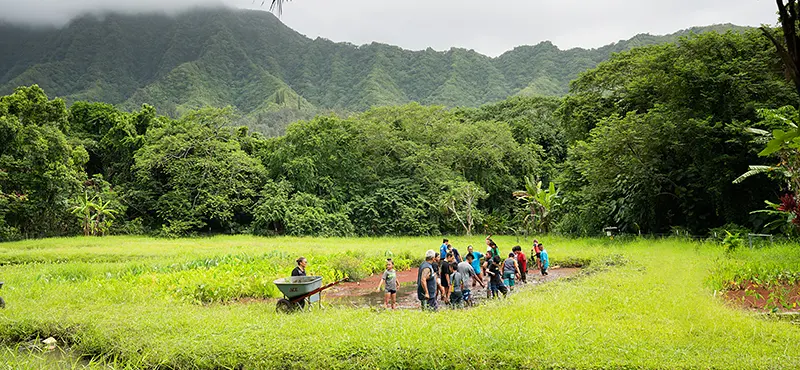If anyone has earned a relaxing retirement, it’s Doug Paneʻe KSK’75. He's back home on Oʻahu after teaching physics, chemistry and geology to high schoolers in Utah for 35 years. He also spent much of that time delivering STEM learning opportunities to Native American students there.
For Paneʻe, hoʻomaha can wait. Ever the mentor, he’s creating new STEM pathways and among those benefiting are some haumāna kaikamahine from KS Kapālama and KS Hawaiʻi.
On a spring Saturday morning, Paneʻe and a handful of haumāna from KS Hawaiʻi and Kapālama filled a trial weather balloon with helium and set it adrift at the black sand beach at Kalapana, Hawaiʻi Island. Aptly named Laʻamaomao, the goddess of wind, the balloon was equipped with a GPS tracker, allowing the team to follow its far-flung journey.

Laʻamaomao team (pictured left to right): Emma Erbe KSH’26, Marley Osorio KSH’26, Sarah Lee KSH’26, Kaylin “Mika” Ing KSK’27, Doug Paneʻe KSK’75. Not pictured: Sarah Kau KSH’28.
Laʻamaomao team (pictured left to right): Emma Erbe KSH’26, Marley Osorio KSH’26, Sarah Lee KSH’26, Kaylin “Mika” Ing KSK’27, Doug Paneʻe KSK’75. Not pictured: Sarah Kau KSH’28.
Paneʻe says missions like these follow in the footsteps of our wayfaring kūpuna who pushed the boundaries as they traversed Moananuiākea.
“We're connected to everything around us. For instance, in Europe, early ships would only sail within sight of land, until eventually explorers decided to look beyond. And yet, the Hawaiians were already sailing across the Pacific. The boundary wasn't a boundary. It was more like a highway for the voyagers,” said Paneʻe.
Laʻamaomao’s alanui was the skies above. Over the course of just 11 days, it traversed over 18,000 miles, soaring to heights of 40,000 feet. Buffeted by winds and aided by favorable conditions, the balloon passed by Mauna Kea, Mauna Loa, crossed the Pacific Ocean, Mexico, the Caribbean, the Atlantic Ocean, North Africa and the Himalayas before touching down in the Tibetan Plateau.
As haumāna collected scientific data, like wind speeds, altitude and atmospheric conditions, they also learned about the world.
“It's a great geography lesson. Tracking its journey through the app leads students to ask questions like: ʻWhere is that? Where is it above? What kind of language do they speak?’” said Paneʻe.
This experiment is just one of a series of test balloons. With support from NASA through connections Paneʻe established while in Utah, haumāna and researchers eventually want to launch a much larger balloon that travels higher and farther. The goal is to learn whether viruses and bacteria can survive in the jet stream to find new hosts and propagate thousands of miles away.
The trial runs are meant to refine techniques and technologies. And while it’s unclear exactly when the actual balloon launch will happen, one thing is clear: Paneʻe is helping to break a hidden barrier that hinders girls from pursuing STEM careers.
“We're seeing a lot of data where girls excelled in math and science in the earlier grades and then they didn't pursue STEM careers after that,” said Paneʻe.
Recent data from the U.S. Bureau of Labor Statistics finds wāhine account for only 24% of engineering degrees and fill just 16% of engineering positions.
These balloon launches do more than stoke interest in STEM. Being part of a NASA-affiliated project is a major resume booster for college-bound haumāna as demonstrated by the results from a previous cohort.
“It was a great opportunity for these girls. We’ve gotten letters of commendation from U.S. Senator Mazie Hirono, Congressman Ed Case, Governor Josh Green, former Hawaiʻi Island Mayor Mich Roth and Honolulu Mayor Rick Blangiardi. All these accolades helped haumāna when they were applying for college scholarships,” said Paneʻe.
Much of the project's funding and support comes from the North American Native Research and Education Foundation. It's also backed by the Utah NASA Space Grant Consortium.
TAGS
ks hawaii,
alumni,
ks kapalama
CATEGORIES
Kaipuolono Article, Regions, Kona, O’ahu, East Hawai’i, Themes, Culture, Community, Hawaii Newsroom, KS Hawaii Home, Kapalama Newsroom, Kapalama Home, Newsroom, Hawaii, Kapalama, Alumni, Midwest Region, Intermountain Region, Kapalama, Hawaii campus, Kapalama campus, Maui campus, Preschools
Print with photos
Print text only










